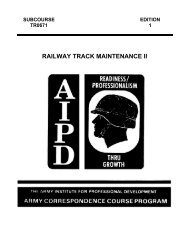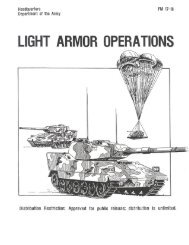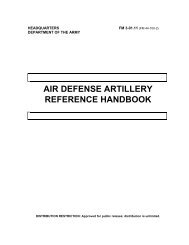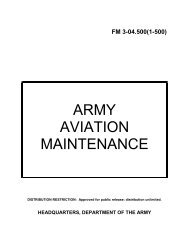fm 44-100 us army air and missile defense operations
fm 44-100 us army air and missile defense operations
fm 44-100 us army air and missile defense operations
You also want an ePaper? Increase the reach of your titles
YUMPU automatically turns print PDFs into web optimized ePapers that Google loves.
FM<strong>44</strong>-<strong>100</strong><br />
5-4<br />
deviations, <strong>and</strong> p<strong>us</strong>h analyzed information to the comm<strong>and</strong>er. Staffs acquire<br />
<strong>and</strong> apply means to carry out the comm<strong>and</strong>er's intent <strong>and</strong> develop specific<br />
instructions from general guidance.<br />
5-17. Control provides the means to regulate, to synchronize, <strong>and</strong> to monitor<br />
forces <strong>and</strong> functions through collection, f<strong>us</strong>ion, assessment, <strong>and</strong><br />
dissemination of information <strong>and</strong> data. Control is associated with functional<br />
areas <strong>and</strong> depends upon data <strong>and</strong> information systems. It allows the<br />
comm<strong>and</strong>er through the staff to monitor the stat<strong>us</strong> <strong>and</strong> efforts of the<br />
comm<strong>and</strong> <strong>and</strong> adjacent units <strong>and</strong> to maintain situation awareness<br />
throughout the battlespace. Responsive control means (communications,<br />
computers, <strong>and</strong> sensors) allow the comm<strong>and</strong>er to manage <strong>and</strong> direct the<br />
process.<br />
5-18. The communications segment of the battle comm<strong>and</strong> <strong>and</strong> intelligence,<br />
surveillance <strong>and</strong> reconnaissance (ISR) systems m<strong>us</strong>t provide information<br />
quickly <strong>and</strong> with reasonable security, to whomever needs it. Information<br />
transfer between sensors <strong>and</strong> weapon systems or forces is necessary in every<br />
type <strong>and</strong> level of battle management. Information-age technology can provide<br />
the comm<strong>and</strong>er an abundance of near-real-time information that can, if<br />
properly presented, reduce uncertainty <strong>and</strong> conf<strong>us</strong>ion. However, if improperly<br />
managed, it could burden the comm<strong>and</strong>er.<br />
5-19. Speed of <strong>operations</strong> has quickened beca<strong>us</strong>e of advances in the rate of<br />
intelligence <strong>and</strong> information flow. The ability to gather, manage, process, <strong>and</strong><br />
circulate near-real-time information among sensors, weapons, <strong>and</strong> highly<br />
mobile forces give operational <strong>and</strong> tactical comm<strong>and</strong>ers the means to set<br />
battle tempo. Tempo is a function of speed of <strong>operations</strong> within time to<br />
accomplish missions based on the comm<strong>and</strong>er's plan <strong>and</strong> available resources.<br />
5-20. Tempo requires both mental <strong>and</strong> physical agility by leaders <strong>and</strong><br />
organizations. Comm<strong>and</strong>ers m<strong>us</strong>t underst<strong>and</strong> these relationships <strong>and</strong><br />
manage them effectively. Comm<strong>and</strong>ers m<strong>us</strong>t possess the mental agility <strong>and</strong><br />
discipline to make timely decisions to modify the tempo to their advantage,<br />
deny the enemy the initiative, <strong>and</strong> decisively defeat it at the selected time<br />
<strong>and</strong> place.<br />
BATTLE COMMAND SYSTEMS<br />
5-21. The battle comm<strong>and</strong> system m<strong>us</strong>t support the ability of the comm<strong>and</strong>er<br />
to adj<strong>us</strong>t plans for future <strong>operations</strong> while foc<strong>us</strong>ing on the current fight. The<br />
battle comm<strong>and</strong> system for <strong>air</strong> <strong>defense</strong> is grouped into two categories,<br />
engagement <strong>operations</strong> (EO) <strong>and</strong> force <strong>operations</strong> (FO). EO <strong>and</strong> FO functions<br />
are closely related. There is a real-time interaction that takes place between<br />
many of the EO <strong>and</strong> FO functions during battle. This interaction results in<br />
continued force optimization as the battle progresses. The related tools for<br />
implementing comm<strong>and</strong> decisions include communications <strong>and</strong> computers.<br />
5-22. Reliable communications are imperative to battle comm<strong>and</strong> <strong>and</strong> control.<br />
Effective battle comm<strong>and</strong> requires reliable signal support systems to enable<br />
the comm<strong>and</strong>er to conduct <strong>operations</strong> at varying tempos over extended<br />
distances. Good signal planning increases the comm<strong>and</strong>er's options to exploit<br />
success <strong>and</strong> facilitate future <strong>operations</strong>. The battle comm<strong>and</strong> style of the<br />
comm<strong>and</strong>er dictates the structure of his supporting communications system.











